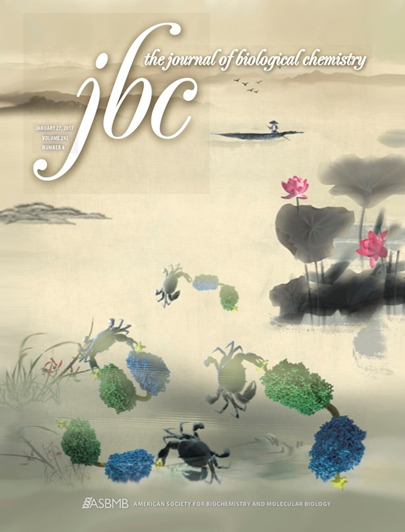Recently, studies from Prof. Chun Tang’s lab in WIPM collaborated with Prof. Meng-Qiu Dong’s lab in National Institute of Biological Sciences, Beijing (NIBS) entitled “Modeling protein excited-state structures from "over-length" chemical cross-links” is published in The Journal of Biological Chemistry. The research team successfully explored the use of chemical cross-linking coupled with mass spectrometry (CXMS) and structural refinement to investigate the protein dynamics, and released a common process (http://www.jbc.org/content/early/2016/12/19/jbc.M116.761841.abstract?ctkey=spe#xref-corresp-1-1)
Present-day structural biology largely focuses on the predominant ground-state structures of proteins, which are most populated and readily detectable. Nevertheless, it is becoming clear that a protein can transiently adopt alternative, often lowly populated excited-state conformations. Dynamic inter-conversion between protein ground and excited states, together constituting the ensemble structures of a protein, enables the protein to perform its function. For a multi- domain protein, the dynamics usually involve the rearrangement between the domains, which can be essential for ligand recognition, catalytic activity, and allosteric modulation of the protein. Despite technical advances in X-ray crystallography, nuclear magnetic resonance (NMR) spectroscopy, and cryo-electron microscopy, the excited states of proteins remain difficult to characterize. Among the existing techniques, NMR spectroscopy is known for identifying the excited states and for elucidating protein dynamics. Yet NMR requires a large quantity of purified, isotopically enriched recombinant proteins, and is mainly applicable to proteins <50,000 Da.
Chemical cross-linking of proteins coupled with mass spectrometry (CXMS) is an emerging technique in structural biology, and has been increasingly used for modeling protein structures. The cross-linked residues that are identified by high-resolution mass spectroscopy should be close to each other, within the reach of the cross- linker used. However, it has been shown that the straight-line distance between the Cα atoms of cross-linked residues calculated from the known structure sometimes exceed the maximum length of the cross-linker. Yet, even after eliminating erroneous assignments with stringent criteria, the discrepancy persists. As a common practice in protein structure modeling, the distance restraints derived from the "over-length" cross- links were often relaxed or even discarded. Two laboratories in this paper collaborated to find that the “over-length” cross-links with high-confidence reflect the weak or transient interactions between proteins a year ago(Gong Z, Biophysics Reports 2016). Today, the authors reason that over-length intramolecular cross-links can be explained by the dynamic movement between different parts of the protein. Based on the cross-links identified with high confidence, the alternative closed conformation of ligand-free Ca2+-CaM was obtained, which is close to theexited states observed from PRE-NMRand the closed-state structures of ligand-bound Ca2+-CaM . Thus, a cognate ligand of Ca2+-CaM can stabilize the closed-state structure already present for ligand-free Ca2+-CaM , which is characteristic of a conformational selection mechanism. Using the same strategy with the over-length cross-linksfrom a bacterial phosphotransferase (EIN) ora ligand-free glutamine binding protein (QBP), the authors found a two- conformer representation for EIN and QBP that can account for all intramolecular cross-links.The over-length cross-links allowed us to model the transiently closed conformation of ligand-free Ca2+-CaM with a population of only ~5% (Data from NMR experiments). For EIN and QBP, the alternative conformation should have a low occupancy and could not be observed without the addition of an inhibitor or introduction of a point mutation in the past. Unlike NMR, CXMS is not limited by the size of the protein. Thus the CXMS is highly sensitive to the lowly populated conformational states of proteins.
To account for all intramolecular cross-links identified with high confidence, the authors present a method for assessing the conformational fluctuations of multi-domain proteins (the associated software DynaXL is freely available at http://www.tanglab.org/resoures). In this method, the cross-linkers are represented with atomic details, and the protein alternative conformations are modeled with conjoined rigid body/torsion angle simulated annealing. DynaXL takes as input the known PDB structure of a protein and a list of high-confidence intramolecular cross-links obtained from CXMS analysis on a 1:1 mixture of the 14N- and 15N- labeled proteins. The software also provide the friendly visual user interface. All inter- domain cross-links involving rigid residues are used for characterizing protein ensemble structure that comprises the ground-state conformation and any additional excited-state conformation. If a two-conformer ensemble structure cannot account for all inter-domain cross-links, DynaXL attempts a three-conformer ensemble structure, and so on, until all cross-links are satisfied.
At the same time with the acception of the paper, the cover design submitted by the research team also stands out from the many candidates, selected as the journal cover by The Journal of Biological Chemistry, and published on 27th Jan. The date of publication coincides with the Chinese New Year's Eve, which is the best New Year gift for the research team.
Associate Professor Zhou Gong from WIPM and Dr. Yuehe Ding from NIBS are the first authors of this article. Assistant researcher Kan Liu from WIPM design the DynaXL software. This study was funded by the Minstry of Science and Technology、National Natural Science Foundation of China、Howard Hughes Medical Institute (HHMI) and Beijing Government.
